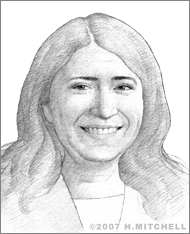Radia Perlman
During the 1970s scientists and programmers were working hard on assembling the networks and technology to enable what we now know as the Internet. Engineer and mathematician Radia Perlman was one of very few women involved in process at that time. Her invention of the algorithm behind the Spanning Tree Protocol solved a challenging information routing problem and earned her the moniker “Mother of the Internet.”
Born in 1952 in Portsmouth, Va., Perlman spent much of her childhood in New Jersey. She attended the Massachusetts Institute of Technology, graduating with a SB degree in 1973 and an SM in 1976, both in mathematics. From there she accepted a position with Bolt, Berenek, Newman (BBN), a government contractor that developed software for network equipment.
While working for BBN, Perlman made an impression on a manager for Digital Equipment Corp. while making a presentation on network routing. Digital offered her a job; she joined the firm in 1980. Digital had been trying to get computers to share information in a reliable manner and asked for her help. She very quickly produced a solution that did exactly what the team wanted it to; the Spanning Tree Protocol (STP), allows a network to deliver data reliably by making it possible to design the network with redundant links. This setup provides automatic backup paths if an active link fails, and disables the links that are not part of the tree. This leaves a single, active path between any pair of network nodes.
Perlman’s work has been described as having put the “basic traffic rules into place” for the Internet. STP ensures that a network remains configured in any event to ensure that data is delivered whenever a user or machine calls for it. The concept was adopted as an IEEE standard for bridge technology and remains in place to this day. Perlman also developed algorithms to make link state protocols such as IS-IS and OSPF efficient and scalable.
Perlman earned her PhD in computer science from MIT in 1988; her doctoral thesis on routing in environments where malicious network failures are present serves as the basis for much of the work that now exists in this area. She left Digital in 1993 to work for Novell and in 1997 she joined Sun Microsystems. Over the course of her career she has earned some 80 patents, 40 of them while working for Sun Microsystems, where in 2007 she held the title of Distinguished Engineer. She also served as a professor at both Harvard University and the University of Washington, and she has written or co-written two textbooks: “Interconnections: Bridges, Routers, Switches, and Internetworking Protocols”; and “Network Security: Private Communication in a Public World.”
At Sun Microsystems, Perlman specializes in network security. Her focus was on redesigning the algorithm behind STP to make it more robust, more stable, and give it the ability to establish optimal paths between points. The project went by the name of TRILL, which stands for "transparent interconnection of lots of links." She also worked for several years on a project she calls an “ephemerizer.” The concept would allow users to assign single, dated encryption keys to create entire batches of files so a user or administrator need keep track of only one key for any subset of files. The system would also help users ensure that encrypted data is inaccessible after the expiration date; on a date chosen by a user, corresponding encryption keys would be destroyed.
Perlman has been honored with numerous awards for her work. She was named 2004 Inventor of the Year by the Silicon Valley Intellectual Property Law Association and was listed as one of the 20 most influential people in information technology by Data Communications Magazine, in both its 20th and 25th anniversary editions.


